第二章 科技英语构词法
- 格式:ppt
- 大小:299.00 KB
- 文档页数:15
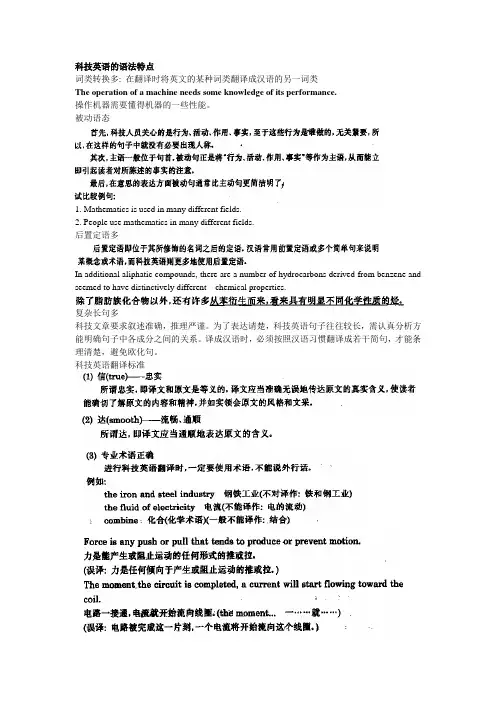
词类转换多: 在翻译时将英文的某种词类翻译成汉语的另一词类The operation of a machine needs some knowledge of its performance.操作机器需要懂得机器的一些性能。
被动语态1. Mathematics is used in many different fields.2. People use mathematics in many different fields.后置定语多In additional aliphatic compounds, there are a number of hydrocarbons derived from benzene and seemed to have distinctively different chemical properties.复杂长句多科技文章要求叙述准确,推理严谨。
为了表达请楚,科技英语句子往往较长,需认真分析方能明确句子中各成分之间的关系。
译成汉语时,必须按照汉语习惯翻译成若干简句,才能条理清楚,避免欧化句。
科技英语翻译标准所谓构词法即词的构成方法.即词在结构上规律.科技英语构词特点1)外来语多(很多来自希腊语和拉丁语);2)构词方法多.除了非科技英语中常用的三种构词法—转化、派生及合成法外,还普遍采用压缩法、混成法.符号法和宇母象形法.3)有大量半科技英语词汇(semi-scientific words)annual output 年产量produce…every year2.1 转化法(conversion)2.2 派生法(derivation)2.3 合成法(composition)由两个或更多词合成一个词,叫合成法。
有时需加连字符。
2.4 压缩法(shortening)只取词头字母ppm:parts per million 百万分之一SEM:scanning electron microscope (扫描电镜)TEM:Transmission electron microscopy(透射电镜)XRD:X-ray diffraction (X-射线衍射)将单词删去一些字母:lab:laboratory 实验室kilo:kilogram 千克、公斤flu: influenza 流行性感冒2.5 混成法(blending)把两个词一头一尾连在一起,构成1个新词.positron=positive+electron正的+电子=正电子medicare=medical十care医学的+照管=医疗保障aldehyde=alcohol十dehydrogenation醇+脱氢=醛2.6 常用后缀、词根第三章科技英语翻译一、词类转化的译法1.1 名词的转译Total determination of molecular structure is possible by means of X-ray diffraction.The maiden voyage of the newly-built steamship was a success.1.2 动词的转译An acid and a base react in a proton transfer reaction.The methyl group on the benzene ring greatly facilitates the nitration of toluene.1.3 形容词的转译英语中有些形容词(短语)表示“愿望、心理、情感”等一类概念,相当于汉语的动词。
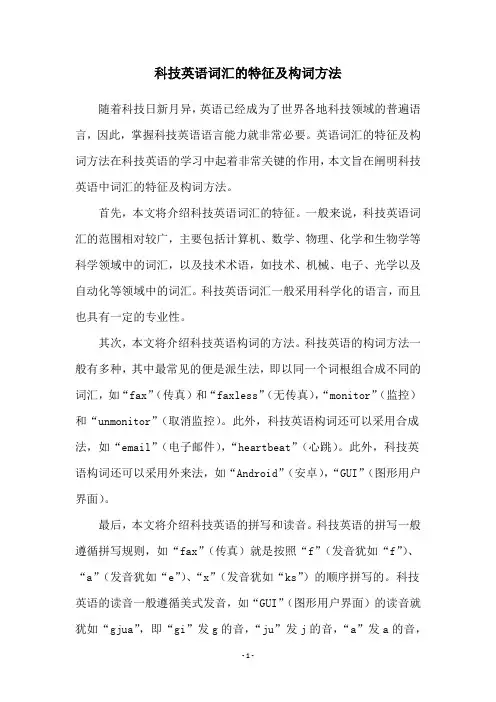
科技英语词汇的特征及构词方法
随着科技日新月异,英语已经成为了世界各地科技领域的普遍语言,因此,掌握科技英语语言能力就非常必要。
英语词汇的特征及构词方法在科技英语的学习中起着非常关键的作用,本文旨在阐明科技英语中词汇的特征及构词方法。
首先,本文将介绍科技英语词汇的特征。
一般来说,科技英语词汇的范围相对较广,主要包括计算机、数学、物理、化学和生物学等科学领域中的词汇,以及技术术语,如技术、机械、电子、光学以及自动化等领域中的词汇。
科技英语词汇一般采用科学化的语言,而且也具有一定的专业性。
其次,本文将介绍科技英语构词的方法。
科技英语的构词方法一般有多种,其中最常见的便是派生法,即以同一个词根组合成不同的词汇,如“fax”(传真)和“faxless”(无传真),“monitor”(监控)和“unmonitor”(取消监控)。
此外,科技英语构词还可以采用合成法,如“email”(电子邮件),“heartbeat”(心跳)。
此外,科技英语构词还可以采用外来法,如“Android”(安卓),“GUI”(图形用户界面)。
最后,本文将介绍科技英语的拼写和读音。
科技英语的拼写一般遵循拼写规则,如“fax”(传真)就是按照“f”(发音犹如“f”)、“a”(发音犹如“e”)、“x”(发音犹如“ks”)的顺序拼写的。
科技英语的读音一般遵循美式发音,如“GUI”(图形用户界面)的读音就犹如“gjua”,即“gi”发g的音,“ju”发j的音,“a”发a的音,
最终结合成“gjua”这种读音。
综上所述,科技英语词汇的特征及构词方法对于科技英语学习至关重要,掌握科技英语词汇的特征及构词方法能够帮助读者更好地掌握科技英语的语言能力。
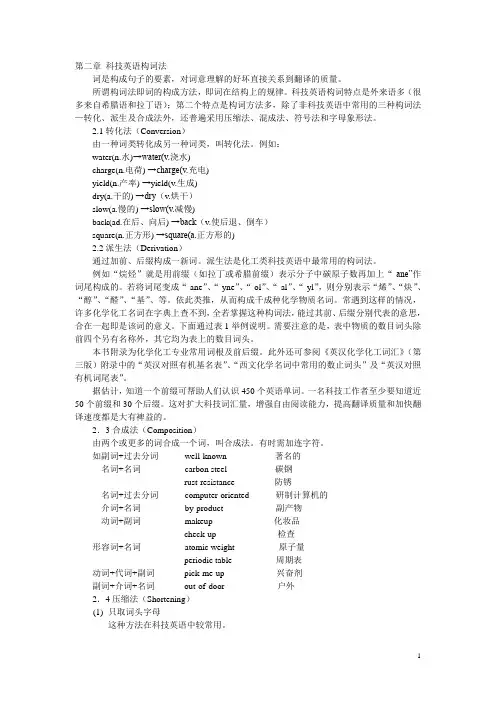
第二章科技英语构词法词是构成句子的要素,对词意理解的好坏直接关系到翻译的质量。
所谓构词法即词的构成方法,即词在结构上的规律。
科技英语构词特点是外来语多(很多来自希腊语和拉丁语);第二个特点是构词方法多,除了非科技英语中常用的三种构词法—转化、派生及合成法外,还普遍采用压缩法、混成法、符号法和字母象形法。
2.1转化法(Conversion)由一种词类转化成另一种词类,叫转化法。
例如:water(n.水)→water(v.浇水)charge(n.电荷) →charge(v.充电)yield(n.产率) →yield(v.生成)dry(a.干的) →dry(v.烘干)slow(a.慢的) →slow(v.减慢)back(ad.在后、向后) →back(v.使后退、倒车)square(n.正方形) →square(a.正方形的)2.2派生法(Derivation)通过加前、后缀构成一新词。
派生法是化工类科技英语中最常用的构词法。
例如“烷烃”就是用前缀(如拉丁或希腊前缀)表示分子中碳原子数再加上“-ane”作词尾构成的。
若将词尾变成“-ane”、“-yne”、“-ol”、“-al”、“-yl”,则分别表示“烯”、“炔”、“醇”、“醛”、“基”、等。
依此类推,从而构成千成种化学物质名词。
常遇到这样的情况,许多化学化工名词在字典上查不到,全若掌握这种构词法,能过其前、后缀分别代表的意思,合在一起即是该词的意义。
下面通过表1举例说明。
需要注意的是,表中物质的数目词头除前四个另有名称外,其它均为表上的数目词头。
本书附录为化学化工专业常用词根及前后缀。
此外还可参阅《英汉化学化工词汇》(第三版)附录中的“英汉对照有机基名表”、“西文化学名词中常用的数止词头”及“英汉对照有机词尾表”。
据估计,知道一个前缀可帮助人们认识450个英语单词。
一名科技工作者至少要知道近50个前缀和30个后缀。
这对扩大科技词汇量,增强自由阅读能力,提高翻译质量和加快翻译速度都是大有裨益的。
![[精品]科技英语构词法和单词](https://uimg.taocdn.com/b63d1812192e45361066f54e.webp)
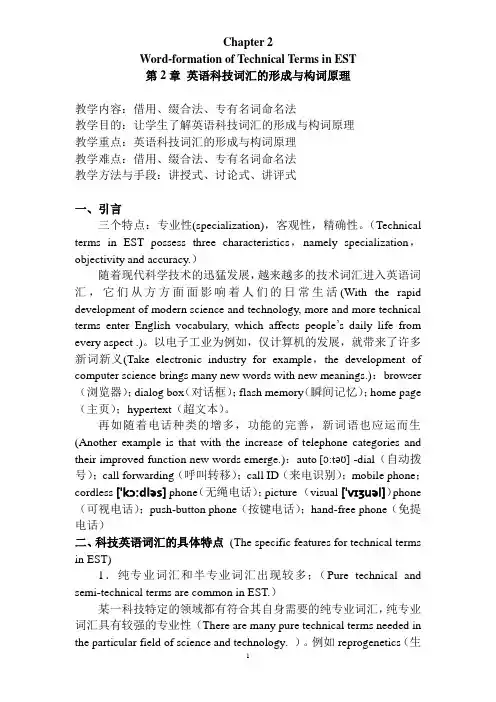
Chapter 2Word-formation of Technical Terms in EST第2章英语科技词汇的形成与构词原理教学内容:借用、缀合法、专有名词命名法教学目的:让学生了解英语科技词汇的形成与构词原理教学重点:英语科技词汇的形成与构词原理教学难点:借用、缀合法、专有名词命名法教学方法与手段:讲授式、讨论式、讲评式一、引言三个特点:专业性(specialization),客观性,精确性。
(Technical terms in EST possess three characteristics,namely specialization,objectivity and accuracy.)随着现代科学技术的迅猛发展,越来越多的技术词汇进入英语词汇,它们从方方面面影响着人们的日常生活(With the rapid development of modern science and technology, more and more technical terms enter English vocabulary, which affects people’s daily life from every aspect .)。
以电子工业为例如,仅计算机的发展,就带来了许多新词新义(Take electronic industry for example,the development of computer science brings many new words with new meanings.):browser (浏览器);dialog box(对话框);flash memory(瞬间记忆);home page (主页);hypertext(超文本)。
再如随着电话种类的增多,功能的完善,新词语也应运而生(Another example is that with the increase of telephone categories and their improved function new words emerge.):auto[ɔ:təʊ] -dial(自动拨号);call forwarding(呼叫转移);call ID(来电识别);mobile phone;cordless[ˈkɔ:dləs] phone(无绳电话);picture (visual[ˈvɪʒuəl])phone (可视电话);push-button phone(按键电话);hand-free phone(免提电话)二、科技英语词汇的具体特点(The specific features for technical terms in EST)1.纯专业词汇和半专业词汇出现较多;(Pure technical and semi-technical terms are common in EST.)某一科技特定的领域都有符合其自身需要的纯专业词汇,纯专业词汇具有较强的专业性(There are many pure technical terms needed in the particular field of science and technology. )。
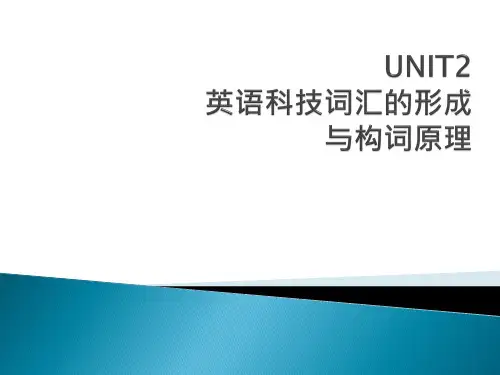
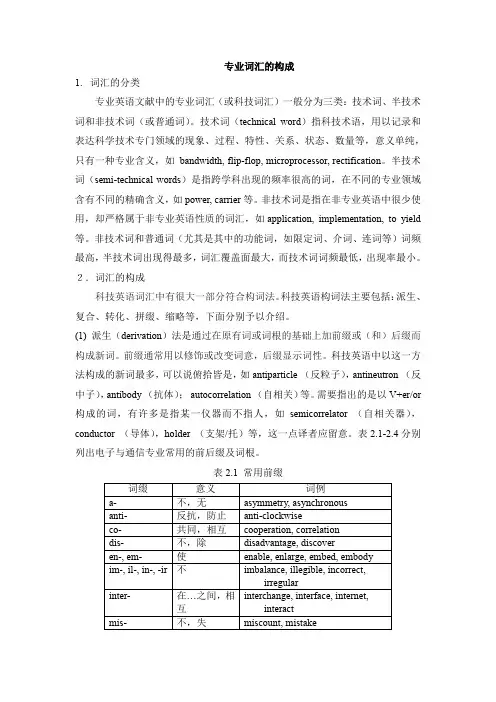
专业词汇的构成1.词汇的分类专业英语文献中的专业词汇(或科技词汇)一般分为三类:技术词、半技术词和非技术词(或普通词)。
技术词(technical word)指科技术语,用以记录和表达科学技术专门领域的现象、过程、特性、关系、状态、数量等,意义单纯,只有一种专业含义,如bandwidth, flip-flop, microprocessor, rectification。
半技术词(semi-technical words)是指跨学科出现的频率很高的词,在不同的专业领域含有不同的精确含义,如power, carrier等。
非技术词是指在非专业英语中很少使用,却严格属于非专业英语性质的词汇,如application, implementation, to yield 等。
非技术词和普通词(尤其是其中的功能词,如限定词、介词、连词等)词频最高,半技术词出现得最多,词汇覆盖面最大,而技术词词频最低,出现率最小。
2.词汇的构成科技英语词汇中有很大一部分符合构词法。
科技英语构词法主要包括:派生、复合、转化、拼缀、缩略等,下面分别予以介绍。
(1) 派生(derivation)法是通过在原有词或词根的基础上加前缀或(和)后缀而构成新词。
前缀通常用以修饰或改变词意,后缀显示词性。
科技英语中以这一方法构成的新词最多,可以说俯拾皆是,如antiparticle (反粒子),antineutron (反中子),antibody (抗体);autocorrelation (自相关)等。
需要指出的是以V+er/or 构成的词,有许多是指某一仪器而不指人,如semicorrelator (自相关器),conductor (导体),holder (支架/托)等,这一点译者应留意。
表2.1-2.4分别列出电子与通信专业常用的前后缀及词根。
表2.1 常用前缀表2.2 表示数量关系的常用前缀表2.3 常用后缀表 2.4 常用词根(2) 复合(composition)法是由两个或两个以上的词按照一定的次序排列,以构成新词,其词性可以是形容词、名词、代词、动词、副词等。
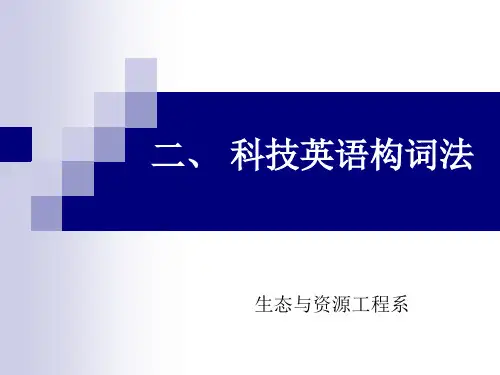
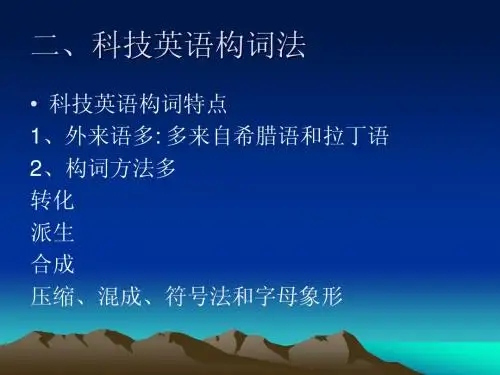
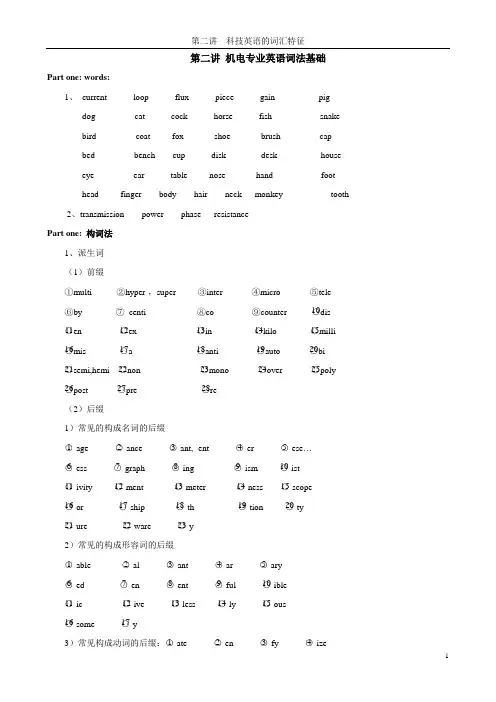
第二讲机电专业英语词法基础Part one: words:1、current loop flux piece gain pigdog cat cock horse fish snakebird coat fox shoe brush capbed bench cup disk desk houseeye ear table nose hand foothead finger body hair neck monkey tooth2、transmission power phase resistancePart one: 构词法1、派生词(1)前缀①multi- ②hyper-,super ③inter- ④micro- ⑤tele-10dis-⑥by- ⑦centi- ⑧co- ⑨counter- ○○11en- ○12ex- ○13in- ○14kilo- ○15milli- 16mis- ○17a- ○18anti- ○19auto- ○20bi-○21semi,hemi ○22non- ○23mono- ○24over- ○25poly- ○26post- ○27pre- ○28re-○(2)后缀1)常见的构成名词的后缀○1-age ○2-ance ○3-ant, -ent ○4-er ○5-ese…○6-ess ○7-graph ○8-ing ○9-ism ○10-ist○11-ivity ○12-ment ○13-meter ○14-ness ○15-scope16-or ○17-ship ○18-th ○19-tion ○20-ty○21-ure ○22-ware ○23-y○2)常见的构成形容词的后缀○1-able ○2-al ○3-ant ○4-ar ○5-ary○6-ed ○7-en ○8-ent ○9-ful ○10-ible○11-ic ○12-ive ○13-less ○14-ly ○15-ous16-some ○17-y○3)常见构成动词的后缀:○1-ate ○2-en ○3-fy ○4-ize4)常见的构成副词的后缀:○1-ly ○2-wards ○3-wise2、合成词1)合成名词○1名词+名词○2名词+动名词○3动名词+名词○4形容词+名词○5动词+名词○6副词+动词○7动词+副词2)合成形容词○1名词+现在分词○2名词+过去分词○3形容词+现在分词○4形容词+过去分词○5形容词+名词○6形容词+名词+ed○7形容词+形容词○8数词+名词○9数词+名词+ed10副词+现在分词○11副词+过去分词○12介词或副词+名词○3)合成动词:○1名词+动词○2形容词+动词○3副词或介词+动词3、转化法1)名词转化为动词2)动词转化为名词3)形容词转化为名词4、缩略词1)节略词(clipped words):maths, ad, dir, lab2)首字母(Initials):CAD, CAM, CAE, VM, QIS, DB, ES, CPU, DBMS,CGA,ROM, RAM3)缩写词(Abbreviation):e.g., Ltd., sq.5、拼缀法:programmatic,telecamera,comsat,forexPart three: Drills:1 There is no physical contact between tool and work piece.2 Public opinion is demanding more and more urgently that something must be done about noise.3 There is a wide area of performance duplication between numerical control and automatics.4 High-speed grinding does not know this disadvantage.5 You found that, in two experiments, hardness and greenness in apple went together with sourness.6 Gasses differ from solids in that the former has greater compressibility than the latter.7 The instrument is characterized by its compactness, and portability.8 The cutting tools must be strong, tough, hard and wear resistant.9 Dynamics is divided in to statics and kinetics, the former treating of force in equilibrium, the latter of the relation of force to motion.10 The image must be dimensionally correct11 The application of electronic computers makes for a tremendous rise in labor productivity.12 In any machine input work equals output work plus work done against friction.13 Scientists are confident that all matter is indestructible.14 Open the valve to let air in.15 It is a fact that no structural material is perfectly elastic.16 They said that such knowledge is needed before they develop a successful early warning system for earthquakes.17 A continuous increase in the temperature of the gas confined in a container will lead to a continuous increase in the internal pressure with in the gas.18 it is our great pleasure to note that China will sooner join the WTO.19 Like charges repel, while unlike charges attract.Things like air, water or metals are matter.Like knows like.I hope I can use the computer like you do.Do you like this color TV set?20 The instrument is very light.The cover of the meter is light blue.。
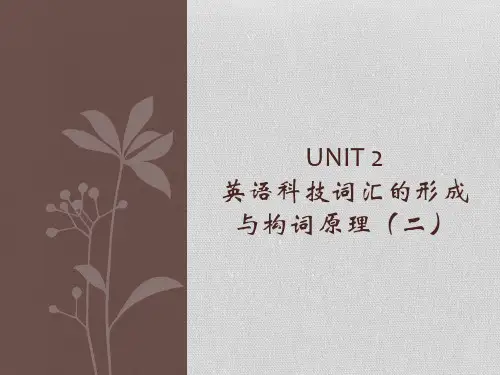
科技英语新词迅速发展的原因及构词方式随着科技的不断进步,许多新领域和新技术不断涌现,这也就导致了科技英语新词的不断出现和迅速发展。
科技英语新词的构词方式也非常独特,主要包括以下几种:
1. 合成法:将两个或多个单词合成一个新词。
例如,smartphone (智能手机)就是由smart(聪明的)和phone(电话)两个单词组合而成。
2. 缩略法:将一个长单词或组合词缩短成一个简短的词汇。
例如,app(应用程序)就是application(应用程序)的缩略词。
3. 借词法:将其他语言的单词直接引用到英语中。
例如,karaoke (卡拉OK)就是从日语中借来的词语。
4. 后缀法:在单词的末尾加上一个后缀,使其变成新词。
例如,cybersecurity(网络安全)就是由cyber(网络)和security(安全)两个单词组合,再在末尾加上-ity后缀构成的。
综上所述,科技英语新词的迅速发展是由于科技发展的速度非常快,需要新的词汇来描述。
而构词方式则是根据新词的概念和特点来灵活运用的。
- 1 -。
英语科技术语的构词特点及其翻译英语科技术语的构词特点及其翻译一、科技英语术语的构词特点(一)合成性。
有些词汇具有将两个或两个以上的词合成为一个词的特性。
它常体现于科技英语术语的构词法中,在上下文里,读者往往都能够见词明义,一般不会产生误解。
此构成法又可分为合成名词、合成形容词两类。
1、合成名词(1) 名词+名词由两个或两个以上的名词合成一个合成名词,前面名词是说明性的,后一个名词是中心词,如:nuclear bomb原子弹crosstalk串音,串话glassware玻璃制品access control准人控制network computer网络计算机multimedia computer多媒体电脑management information system管理信息系统rust resistance防锈water vapor水蒸气laser disk镭射光盘card reader读卡机cash register现金出纳机pain killer止痛药analog computer模拟计算机等(2) 形容词+名词由一个形容词加一个名词构成,其意义关系是前者修饰后者,如:loudspeaker扩音器firm acceleration稳定加速intelligent card,智能卡virtual reality虚拟现实digital interface数字接口(3) 动名词+名词在这类名词中,动名词所表示的是与被修饰词有关的动作,而名词所表示的是可用的器物或场所等。
如:processing unit处理器flying suit飞行衣welding machine焊接机launching site发射场(4) 名词+动名词如:organ transplanting器官移植data processing数据处理shipbuilding造船current steering电流引导machine shaping加工成型real- time processing实时处理computer programming计算机编程batch processing批处理screen coatings 屏幕涂层。